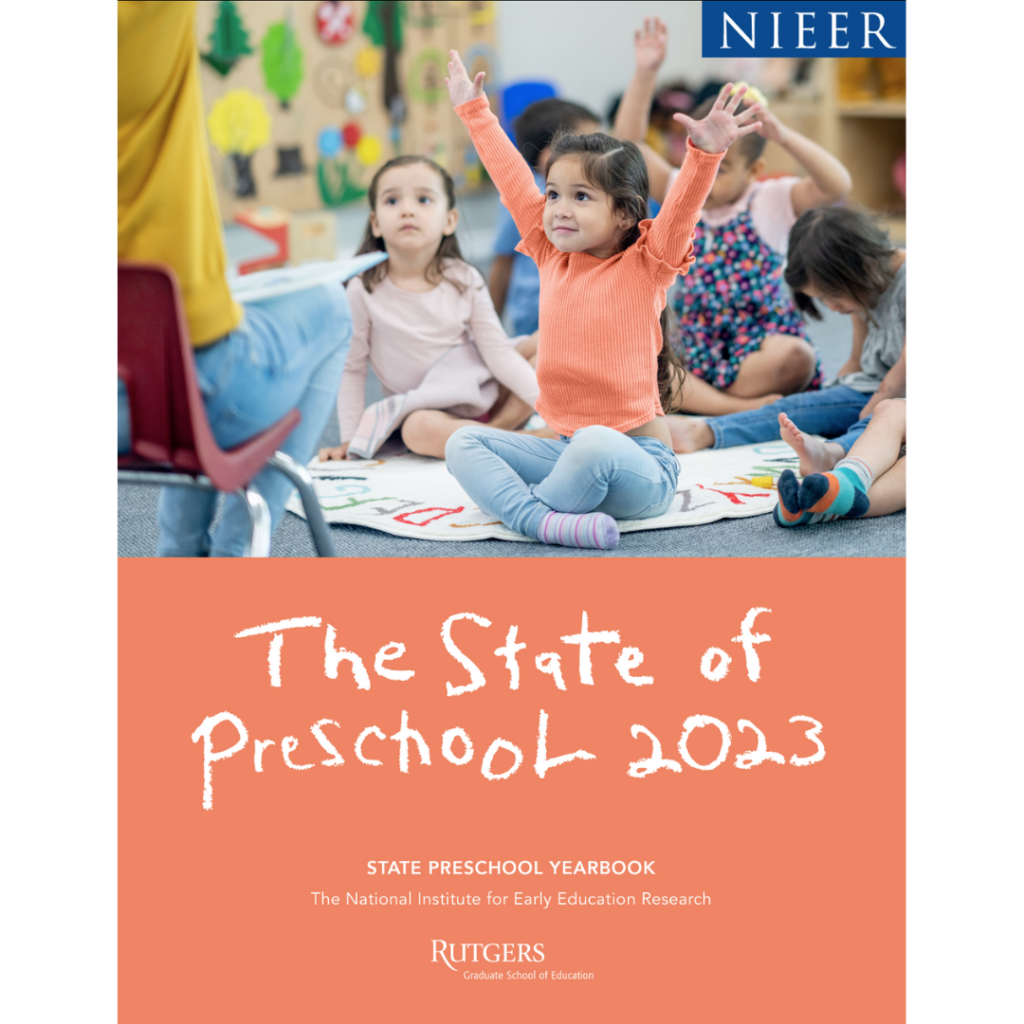2024 Georgia Legislative Pre-K Reforms Return the State to National Leadership in Preschool Access, Quality

The National Institute for Early Education Research (NIEER) today released its annual State of Preschool report, which tracks preschool enrollment, funding, and quality across states. In particular, NIEER’s Senior Co-Director, W. Steven Barnett, shouts out Georgia’s $97 million investment in Pre-K, which was approved by state lawmakers last month. We hope this affirmation will inspire Governor Kemp to keep that $97 million in his final budget! We eagerly await his signature.
Read on for NIEER’s release about the Georgia’s 2023 performance. And click here for the full State of Preschool Yearbook.
NEW BRUNSWICK, N.J. – A new national report released today ranks Georgia 9th in the nation for preschool enrollment for four-year-olds, but 25th in per-pupil spending. A $97 million investment in the program approved by Georgia lawmakers last month should set Georgia on a path to improvement in both per-pupil spending and quality.
The 2023 State of Preschool Yearbook found that, in the 2022-2023 school year:
- Georgia’s Pre-K Program enrolled 73,462 children, an increase of 285 from the prior year.
- State spending totaled $388,314,860, and an additional $26,471,608 in federal recovery funds supported the program, up $1,902,930 (0.5%), adjusted for inflation, since last year.
- State spending per child (including federal recovery funds) equaled $5,646 in 2022-2023, up $4 from 2021-2022, adjusted for inflation.
- Georgia met 8 of 10 research-based quality standards benchmarks for minimum quality recommended by NIEER.
Georgia has long been a leader in access to preschool, as one of the first states to set up a “preschool for all” program with a dedicated funding stream. However, Georgia Lottery funding has not always kept up with what is needed to deliver a program with top quality standards. In January, Georgia’s House Working Group on Early Childhood Education issued bold recommendations to enhance Georgia’s Lottery-funded Pre-K Program, which were supported by the Georgia Early Education Alliance for Ready Students (GEEARS) and other advocates.
In the FY 25 budget approved on the final day of the 2024 Georgia General Assembly, state lawmakers approved a $97 million increase for Georgia’s Lottery-funded Pre-K Program, including funding to:
- Ensure salary parity for pre-k lead and assistant teachers with K-12;
- Cap pre-k class size at 20 children;
- Increase start-up grants from $8,000 to $30,000 for new classrooms;
- Support transportation costs; and
- Provide additional operations support.
“We applaud Georgia leaders for supporting a comprehensive package of research-based reforms to improve Georgia’s landmark pre-k program for the next generation. By restoring class sizes to the level recommended for strong student outcomes, Georgia’s pre-k program will become the largest program in the country that meets all 10 quality benchmarks recommended by NIEER,” said W. Steven Barnett, Ph.D., NIEER’s Ssenior Cco-director. “Georgia’s young children and taxpayers will benefit. A key ingredient for pre-k effectiveness is a strong teacher interacting with children one-on-one and in small groups. More of that will happen when class size is limited to 20, and the research is quite clear this leads to long-term student outcomes.”
Nationally, the report finds that this is a critical moment for preschool. The nation has emerged, albeit unevenly, from the COVID-19 Pandemic. States are poised to make new progress toward serving more three- and four-year-olds in high-quality, full-day preschool programs. How each state chooses to move forward – and whether the federal government helps – will determine how much real progress is made. Most states have not committed to serving all children, and even those states that have often fall short. Most states need to increase funding per child substantially to enable providers to meet minimal standards for a high-quality, effective program.
During the 2022-2023 school year, states enrolled over 1.63 million children in preschool, marking a 7% surge compared to the preceding year. Preschool enrollment reached 35% of 4-year-olds and 7% of 3-year-olds, with state expenditures reaching $11.73 billion—an 11% increase from 2021-2022 when adjusted for inflation. Notably, state spending per child surpassed $7,000 for the first time. However, despite this notable progress, most states still fell short of their pre-pandemic preschool enrollment. While several states made strides towards achieving universal preschool access, six states persisted in not allocating any funding for preschool programs.
“With the pandemic in the rear view, it is time for states to choose whether they are going to support high-quality preschool and how,” said Allison Friedman-Krauss, Ph.D., the report’s lead author. “Will states commit to serve three-year-olds in addition to four-year-olds? Will states make the investments needed to ensure that programs are effective? How will states recruit, support, and retain preschool teachers? These decisions will impact millions of children for years to come.”
###
The 2023 State of Preschool Yearbook was supported with funding from the Heising-Simons Foundation and the Bill and Melinda Gates Foundation. For more information and detailed state-by-state profiles on quality, access, and funding, please visit www.nieer.org.
The National Institute for Early Education Research at the Rutgers Graduate School of Education, New Brunswick, NJ, supports early childhood education policy and practice through independent, objective research and the translation of research to policy and practice.